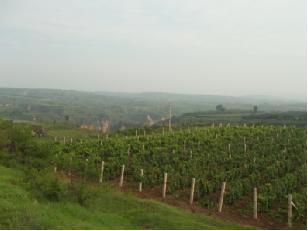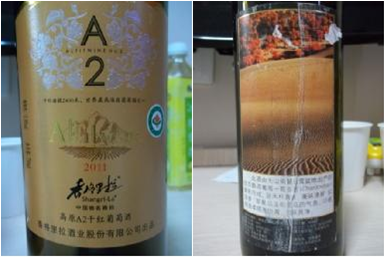Date£º
2014-04-16 13:49 Source£º
http://wineeconomist.com Author:
Cynthia Howson, Pierre Ly and Jeff Begun Translator:
We were lucky to spend a month last summer traveling through several Chinese wine regions, meeting producers, farmers, and experts, and tasting some truly delicious wines.
We were lucky to spend a month last summer traveling through several Chinese wine regions, meeting producers, farmers, and experts, and tasting some truly delicious wines. In past Wine Economist posts, Mike noted that China¡¯s fragmented agriculture was the biggest challenge for Chinese wine producers. How can winemakers ensure a reliable supply of flavorful and fully ripe grapes, when they have to work with hundreds of implausibly small family-run vineyards? Mike pointed out that the best producers are those who somehow solved this problem. Another serious and more permanent challenge comes from the climate. So how did they improve and what¡¯s next?
The grape supply chain

Stunning view at Grace Vineyard in Shanxi province.
Getting control over land is not easy in China and many producers still have to work in large part with hundreds of small family-run vineyards. Yet, some high quality producers have found ways to work with this difficult supply chain by developing relationships with growers. For example, Grace Vineyard, in addition to renting land to grow grapes with their own labor, works with hundreds of very small farmers, and provides them with training and credit for inputs. Grace is willing to pay the price for good quality grapes and provides incentives to farmers accordingly. Of course, at Grace like elsewhere, this takes a lot of work with supervisors going through the vineyards and checking on the work, relationships are not always easy and some compromises may have to be made in difficult vintages to sustain good relationships. But the excellent wines we tasted at places like Grace Vineyard in Shanxi, or Leirenshou in Ningxia, could not have been produced without flavorful, fully ripe fruit and a sizeable portion of it had to come from small family farms.
Of course, it is easier for wineries to secure high quality fruit when it is grown in-house, by renting land to farm with their own employees. Some wineries rent large plots of land directly from the government. Others have to rent from individual farmers, either by dealing with each individual grower directly, or by entering contracts with a village authority which then redistributes rents to individual farmer. In each case, relationships and the local institutional context determine which types of arrangements are feasible and on what terms. Future policies and reforms regarding land markets will certainly play a key role to spread existing improvements in Chinese wine on a larger scale.
Many Chinese terroirs?
So if wineries have found and continue to find ways to improve the grape supply chain, what about the climate? Isn¡¯t China simply too difficult a place to grow high quality wine grapes? People seem to disagree on this issue but what we saw makes us hopeful and optimistic that pockets of high quality will continue to develop.
One source of hope is that China, as one would expect given its size, has many terroirs with incredible diversity. One winemaker told us that opportunities and challenges come together, and this applies to each region in a different way. This post by award-winning winemaker and consultant Professor Li Demei, does a great job explaining the pros and cons of the climate in seven wine regions. For example, toward the Northwest, in Ningxia and Xinjiang, although harsh winters require that vines be buried in winter, reliably hot and dry summers protect the grapes from disease. A reputation for limited or no pesticide use could be a strong selling point, given that food safety incidents in China (including some related to pesticide residue) have received a lot of media attention.
In Shandong province on the East coast, producers enjoy a mild winter and vines do not have to be buried. However, the location also comes with the challenge of humidity and rain during the summer, and especially at harvest. The risk is that people will use pesticides a bit too generously, but careful disease prevention programs can be developed. Emma Gao, from award winning winery Silver Heights, based in Ningxia province, told us she saw a lot of potential for Shandong winemakers, and she compared them to the Burgundians, in the sense that there are many people there willing to put in the hard work needed to overcome challenging conditions. Hardworking Shandong terroiristes overcoming adversity, how interesting would that be! It will be interesting to see future advances there, and it is worth noting that the DBR (Lafite) ¨C Citic project is currently under construction there in a small village next to the resort town of Penglai.
Unlocking China¡¯s terroirist soul

Terroir labeling: the mountains of Alti-wine, and the sandy dunes of Skyline.
That¡¯s what Mike hoped when he wrote about China in Wine Wars. There are many challenges ahead for producers of course, from contracts on land and grapes, to infrastructure and climate. But our last tasting before leaving China gave us further hope. Jim Sun, founder and chief editor of the leading industry media winechina.com, welcomed us at his China-focused cellar in Yantai to share insights, as well as five delicious wines. With passion, Jim told us the story of each of the wines he picked from regions we had not visited, to illustrate a variety of interesting microclimates. The terroir message of each wine was evident, from the Gobi desert vineyard of the Skyline Chardonnay, the vertiginous high altitude of vineyards of the ¡°Altiwine¡± red produced in Yunnan province, to the proximity to a lake that keeps some Cabernet Sauvignon vines cooler than usual in Xinjiang.
Experts seem to disagree on whether China can become a serious producer of fine wine. But there are already some delicious wines, and they each come with their unique and interesting story. That may be enough to get wine enthusiasts interested in China and encourage further progress.
In our next post, we will discuss the role of government in Chinese wine.